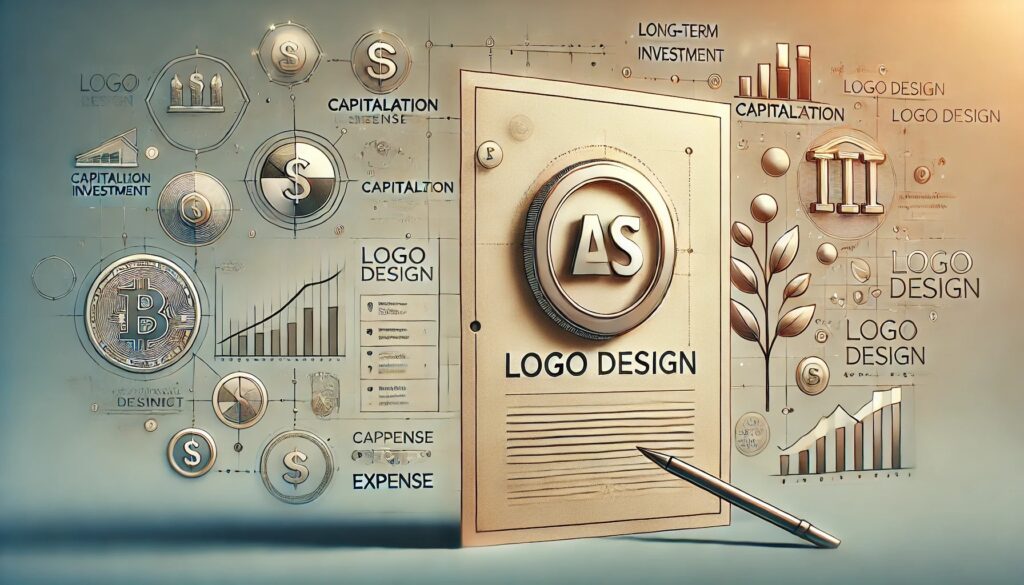“Can logo design be capitalized?” is a question that pops up for many businesses, especially when tax season rolls around. If you’re running a business or starting a new one, understanding whether you can capitalize costs like logo design could save you some serious cash—or at least make your accounting life a little smoother.
Here’s the deal: capitalizing an expense means you’re treating it as an asset, not just a regular expense. It’s like investing in something long-term rather than seeing it as a one-time hit to your budget. So, where does logo design fit into all this? Let’s break it down.
Capitalizing vs. Expensing: What’s the Difference?
Before we get into the nitty-gritty of logo design, let’s quickly talk about capitalizing vs. expensing. When you expense something, the cost hits your profit and loss statement immediately. It’s gone. Done. You bought it, you used it, and that’s that.
On the other hand, capitalizing an expense means you’re treating it as an asset that adds value over time. Instead of deducting the entire cost right away, you spread it out over several years (this process is called amortization). Think of it like buying a piece of equipment for your business—it has long-term value, so the cost is spread out to reflect its usefulness over time.
So, should logo design be treated like a one-time expense or a long-term investment? Let’s dive in.
Is Logo Design a Capital Asset?
The argument for capitalizing logo design comes down to one main idea: a well-designed logo isn’t just a pretty graphic—it’s an essential part of your brand identity. It represents your business and has long-lasting value, often sticking around for years (or even decades).
A strong logo can become an integral part of your brand, something customers recognize instantly. It’s not just a throwaway item; it’s something that can contribute to your business’s overall value for a long time. So, it makes sense to think of it as an asset, right?
Well, sort of.
In many cases, logo design can be capitalized because it’s seen as an investment in your brand. However, it’s not as cut and dried as slapping a “logo design” label on something and calling it an asset. There are rules, and they vary depending on your country and accounting standards.
When Can You Capitalize Logo Design Costs?
Whether or not you can capitalize logo design costs often depends on how the logo is used and the amount spent on it. Generally, logo design can be capitalized when:
The logo is part of a larger rebranding effort: If you’re rebranding your entire business, including a new logo, updated website, and marketing materials, those costs may be considered part of an overall investment in your brand’s future. In this case, the logo could be capitalized because it’s part of a significant, long-term business improvement.
It’s an intangible asset with lasting value: Logos are considered “intangible assets.” Unlike physical assets like equipment or buildings, you can’t touch or feel a logo. But just like a trademark or patent, a logo has long-term value and can be amortized over its useful life.
The cost is significant: This is key. If you spent a few bucks on a logo from a quick freelance job, it might not qualify for capitalization. But if you’ve hired a top-tier design agency and invested heavily in a logo that’s meant to last for years, it could be considered a capital asset.
It’s expected to generate future economic benefits: If the logo is expected to contribute to your future revenue—by helping with brand recognition, attracting customers, etc.—it strengthens the case for capitalization.
When Logo Design Should Be Expensed
Not all logo design costs should be capitalized. Sometimes, it makes more sense to expense the cost, especially when:
The logo is a one-off or temporary: If you’re getting a logo designed for a short-term project or campaign, it doesn’t really have long-term value. In these cases, it’s better to expense the cost upfront.
The cost is minor: For smaller businesses, the cost of logo design might not be significant enough to warrant capitalization. If you’re spending less than what your accounting policy defines as “material,” then it’s typically treated as an expense.
It’s part of ongoing operational expenses: If your logo design is part of a marketing refresh or routine update, it’s often better to expense it. This includes things like redesigning logos for new product launches or tweaking the design for a seasonal campaign.
The Tax Side of Things: Amortization
If you do decide to capitalize your logo design, you won’t just write off the entire cost in one year. Instead, you’ll need to amortize the cost over the asset’s useful life. This is where things can get a bit technical.
For example, you might decide that your new logo will represent your brand for 10 years. In that case, you’d divide the total cost of the logo by 10 and deduct a portion of it each year for 10 years. This helps spread the expense over the period when the asset is generating value for your business.
Tax laws differ depending on where you are, but generally speaking, amortization helps businesses balance out their expenses over time instead of taking a large hit upfront. Always check with a tax professional or accountant to make sure you’re following the correct rules for your region.
Pros and Cons of Capitalizing Logo Design
Pros:
Spreads out costs: If your logo design is a major investment, capitalizing allows you to spread the expense over several years, giving your financial statements a more balanced look.
Recognizes long-term value: Your logo can have long-lasting value for your business. Capitalizing recognizes it as an important asset.
Potential tax benefits: Depending on your tax jurisdiction, capitalizing logo design may provide tax benefits through amortization.
Cons:
Administrative burden: Capitalizing an asset means you need to track its value over time, calculate amortization, and handle more complicated accounting.
Not always straightforward: Determining if logo design qualifies for capitalization can be tricky. The rules aren’t always clear, and it often depends on the specific circumstances.
Potential cash flow issues: While spreading out the cost is useful for some, it might complicate cash flow management for others, particularly small businesses that prefer simple, upfront expenses.
Actionable Steps for Your Logo Design Costs
Review the significance: Look at how much you spent on the logo. If it’s a small expense, it might not be worth capitalizing.
Think long-term: Is this logo part of a major rebrand or long-term investment? If yes, consider capitalizing.
Consult a professional: Tax laws vary, so check with an accountant to ensure you’re making the right decision for your business.
Track the asset: If you capitalize the logo, make sure you’re ready to track it as an asset and amortize the costs over time.
Final Thoughts
Logo design is more than just a cost—it’s an investment in your brand’s identity and future. Whether you should capitalize or expense those costs depends on the situation. If it’s part of a long-term rebranding effort and holds significant value, treating it as an asset might make sense. On the other hand, if it’s a small, one-off expense, it’s probably better to expense it immediately.
Whatever route you choose, understanding how logo design fits into your financial strategy will help you make smarter decisions for your business. Always consult with a tax professional to make sure you’re on the right track.
Ready to build a logo that becomes a true asset? Let’s talk.


